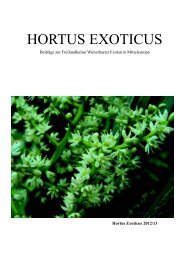Artikel herunter laden - Exotenbuch.de
Artikel herunter laden - Exotenbuch.de
Artikel herunter laden - Exotenbuch.de
Sie wollen auch ein ePaper? Erhöhen Sie die Reichweite Ihrer Titel.
YUMPU macht aus Druck-PDFs automatisch weboptimierte ePaper, die Google liebt.
HORTUS EXOTICUSBeiträge zur Freilandkultur Winterharter Exoten in MitteleuropaHortus Exoticus 14, 20131
Hortus Exoticus 14, 2013Hortus Exoticus - Beiträge zur Freilandkultur winterharter Exoten8. Jahrgang, Heft 14, 2013ISSN 1862-953931. Dezember 2013Herausgeber: Dr. Michael Lorek, Grillparzer Weg 35a, D-42289 Wuppertal, info@tropengarten.<strong>de</strong>Tel.: 0202-624433 Fax: 0202-2545456Erschienen im Verlag TropengartenInhaltsverzeichnisImpressum ............................................................................................................................................................ 2Trocho<strong>de</strong>ndron aralioi<strong>de</strong>s Siebold & Zucc., <strong>de</strong>r Radbaum, Bernd Demes ............................................................. 3Short communication: An uncommon dwarf specimen in the genus Trithrinax Mart., Sergio Quercellini ................ 7Update <strong>de</strong>s winterharten Embothrium coccineum (Proteaceae) – Ökotyp ’San Martin’, Michael Lorek ................. 9Zwei schöne Kalifornierinnen: Romneya und Baum-Anemone, Bernd Demes ...................................................... 14A possible variety of Rhapidophyllum hystrix H. Wendl & Dru<strong>de</strong>, Sergio Quercellini ........................................... 19Myrica gale L., <strong>de</strong>r Gagelstrauch, im exotischen Garten, Michael Lorek ............................................................. 22Alle Winterhärtezonen im Hortus Exoticus beziehen sich auf die mittleren langjährigen Temperaturminima, nachHeinze und Schreiber (1984), siehe auch Hortus Exot. 2006/2: 33–34.Zone 6a: –23,3 bis –20,6 °CZone 6b: –20,5 bis –17,8 °CZone 7a: –17,7 bis –15,0 °CZone 7b: –14,9 bis –12,3 °CZone 8a: –12,2 bis –9,5 °CAutorenhinweise1. Manuskripte können eingereicht wer<strong>de</strong>n als Papier-Ausdruck (mit weißen Seitenrän<strong>de</strong>rn) o<strong>de</strong>r in elektronischerForm. Gleiches gilt für Photographien (digitale Photos min<strong>de</strong>stens 300 dpi) o<strong>de</strong>r Zeichnungen.2. Erwünscht sind Beiträge, die sich mit <strong>de</strong>m Thema “winterharte Exoten“ in Mitteleuropa beschäftigen o<strong>de</strong>rthemenverwandt sind. Sprache möglichst Deutsch o<strong>de</strong>r Englisch, Abstract in Englisch und (nicht mehr als sechs)Keywords, alphabetisch geordnet. Möglichst maximal acht Seiten Text. Gemäß Du<strong>de</strong>n hinter Interpunktionen -außer bei Datumsangaben - bitte stets ein Leerzeichen.3. Formatierung: Halbfett nur für Uberschriften, kursiv für wissenschaftliche Gattungs- und Artnamen (einschließlichinfraspezifischer Taxa) sowie Abstract, Keywords und Bildlegen<strong>de</strong>n, ausnahmsweise auch für Hervorhebungen.Unterstreichungen, Sperrungen und Kapitälchen bitte vermei<strong>de</strong>n, Autorennamen somit in Normalschrift. Zitate imText: (Meyer 1997) o<strong>de</strong>r Meyer (1997), wenn mit Seitenzahl: (Meyer 1997: 12) o<strong>de</strong>r Meyer (1997: 12), bei zweiAutoren: Meyer & Müller (1997: 12), bei mehreren Autoren: Meyer et al. (1997: 12).4. Literaturliste: Nur die im Text zitierten Quellen angeben.Zeitschriften: Meyer, K. 1997: Exotische Pflanzen. – Hortus Bot., 6, 23–27.Bücher: Meyer, K. 1997: Winter und Exoten. – Exoten-Verlag, Stadthausen, 208 S.Zwei Autoren: Meyer, K. & Müller, L. 1997. Mehr als zwei Autoren: Meyer, K., Müller, L. & Schmidt, G. 1997.Mehrbändige Ausgaben: Meyer, K. 1997: Winter und Exoten. Bd. II. – Exoten-Verlag, Stadthausen, 208 S.Jahrgangsgleiche Zitate: Meyer, K. 1996a und Meyer, K. 1996b.5. Für unverlangt eingesandte Manuskripte besteht kein Abdruck- und Rückgaberecht.Umschlagphoto: Trocho<strong>de</strong>ndron aralioi<strong>de</strong>s Siebold & Zucc. im Yangminshan Nationalpark, Taiwan, 03.10.2012,Bernd DemesDieses Werk ist urheberrechtlich in allen seinen Teilen geschützt. Je<strong>de</strong> Verwertung außerhalb <strong>de</strong>r engen Grenzen <strong>de</strong>sUrheberrechtsgesetzes ist ohne Zustimmung <strong>de</strong>s Verlages unzulässig und strafbar. Dies gilt insbeson<strong>de</strong>re fürVervielfältigungen, Übersetzungen und Mikroverfilmungen, sowie die Verarbeitung und Speicherung in elektronischenMedien o<strong>de</strong>r auf optischen Speichern.2
Hortus Exoticus 14, 2013Fig. 2 Comparison between the leaves of the twoRhapodiphyllum hystrix forms. On the left a leaf ofthe taller palm5) It is less suckering.6) In the Mediterranean climate of the author’s gar<strong>de</strong>nnear the coast of central Italy, it flowers twice a year,in late April and in the beginning of July instead ofusually only once in April.7) Its behaviour has been hitherto every yearFig. 4 Comparison between the petiole`s lengths. Onthe right a leaf of the taller palmpolygamous while that of the other male specimenremains dioecious (Fig. 5).In 2002 Jack Scheper, who was in search of wildRhapidophyllum hystrix palms, reported that heobserved in Central Florida some specimens of biggersize, with larger leaves and fewer segments, whileFig. 3 Male inflorescence20
Quercellini: Rhapidophyllum hystrixFig. 5 Inflorescences and infructescences of the taller specimen that is flowering twice a year. On the rightinflorescence (polygamous behaviour) of July 2011 bearing white structures, equivalent of enlarging true fruitsfrom hermaphrodite flowers. In the middle one can see the completely dried inflorescences of April 2011,encompassing only male flowers. On the extreme left an infructescence of the previous year still bearing fruits withseeds from hermaphrodite flowersanother form of R. hystrix is growing in northernFlorida. Probably this latter form (most likely the typicalspecies) extends from northern Florida to the otherstates of the distribution area. Further observations arenee<strong>de</strong>d regarding R. hystrix population in CentralFlorida in or<strong>de</strong>r to check whether it shows all thecharacters given above and, if so, whether suchdifferences might be sufficient for classifying thispopulation as a formal variety of R. hystrix.Fig. 6 Female inflorescenceReferenceScheper J., 2002: Rhapidophyllum hystrix. – http://www.floridata.com/ref/R/rhapido.cfm as per15.09.2013Dr. Sergio QuercelliniVia Città di Castello 3300191 Roma – Italysquercellini@tiscali.it21







